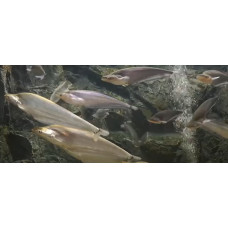Siluridae is a family of fishes of the order Siluriformes. The body is naked. Anal fin is long, dorsal fin is short. The mouth is large with sharp teeth. There are 2-3 pairs of antennae. Brackish-water and freshwater predatory fish living in rivers and lakes of Europe and Asia. Widespread and the most numerous Silurus glanis. It forms a living and passable forms. Has a length of up to 5 m and a mass of more than 300 kg. Spawning is portioned. It lays eggs in the coastal zone, at a depth of 40-50 cm in a nest, which it establishes on a cleared area of the bottom of the reservoir. Siluridae are valuable commercial fish.
A benthic fish widely distributed throughout Eurasia except for the Arctic Ocean basin. There are two species in Europe - Silurus glanis, which reaches a record length of 5 m and Silurus aristotelis. The total commercial catfish catches are about 30 thousand tons, the largest catches are of European catfish. Representatives of the family act as objects of sport and amateur fishing. Some species of catfish are kept in aquariums.
Characterized by the following features: the skin is bare or with bony shields, but without scales; antennae are always present; maxillary bones are rudimentary and almost always serve as a support for the antennae; the edge of the upper jaw is formed only by intermandibular bones; suboperculum is absent; swim bladder is usually present; it is connected to the auditory organs by means of auditory ossicles; adipose fins are not always present. Fin extremely variable in size and position; many dorsal and pectoral fins are armed with strongly developed spines. Live in fresh waters of temperate and hot belts, both slow-flowing or standing, and in fast mountain streams; few visit the sea, but keep close to the shores. All are predatory; antennae play a part in attracting prey. Some genera have peculiar adventitious apparatuses, standing in connection with the normal gill; thus, in the East Indies genus Saccohranchus from the gill cavity stretches along the sides of the body and tail on the bag filled from the gill cavity of water, which from time to time ejected by muscle contraction.
Large representatives reach a length of 2-3 m, small ones often do not exceed 15 cm. The body is covered with bare skin, scales and bony plates are absent, the tail is usually much longer than the body and compressed from the sides. The head has a pair of maxillary antennae and one or two pairs of mandibular antennae. Dorsal fin is small (in some species is absent) without a barbed ray, soft rays no more than 7. The pelvic fins are located in the middle part of the abdomen, in many species are reduced in size or absent. There is no adipose fin. Anal fin is strongly elongated, composed of 41-110 rays. Coloration within the family varies from brown-green to almost transparent.
Almost all Siluridae are freshwater fish, but some species (e.g., Amur catfish) may enter estuaries. They lead a benthic lifestyle. Obligate predators, feeding mainly on fish. Fertilization is external. Females lay eggs on aquatic vegetation. Some species are characterized by nest building and protection of clutches and larvae.
Siluridae
Tags: siluridae



